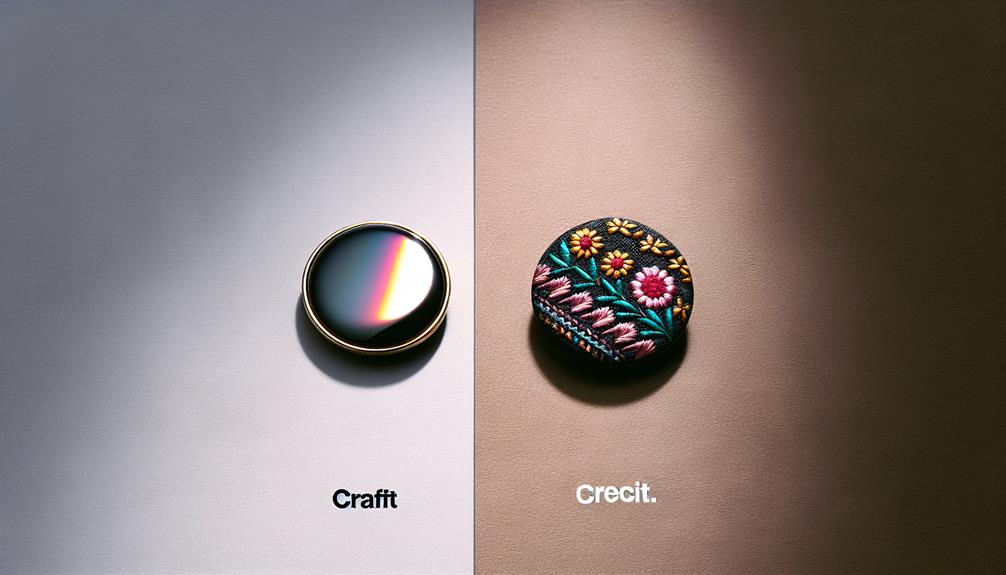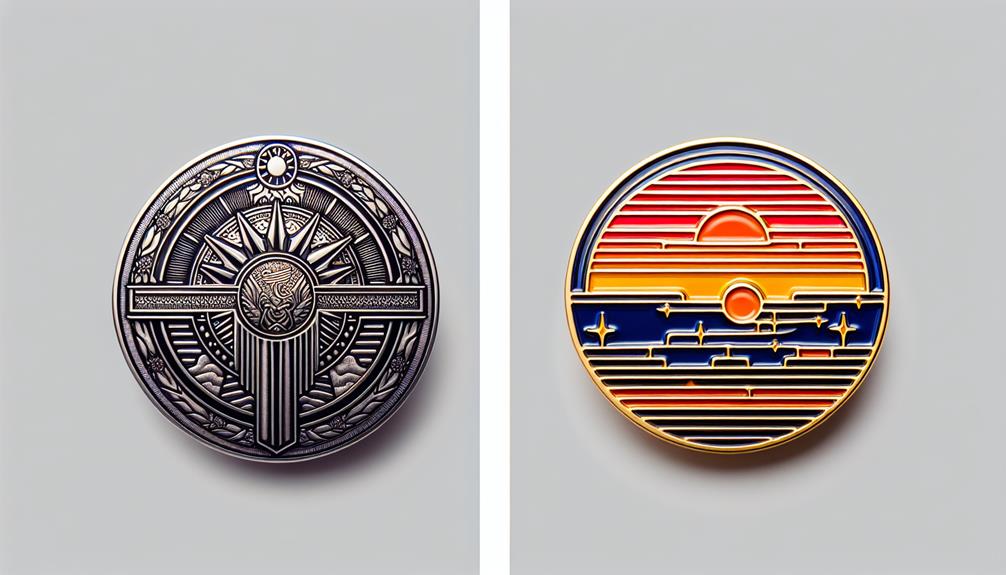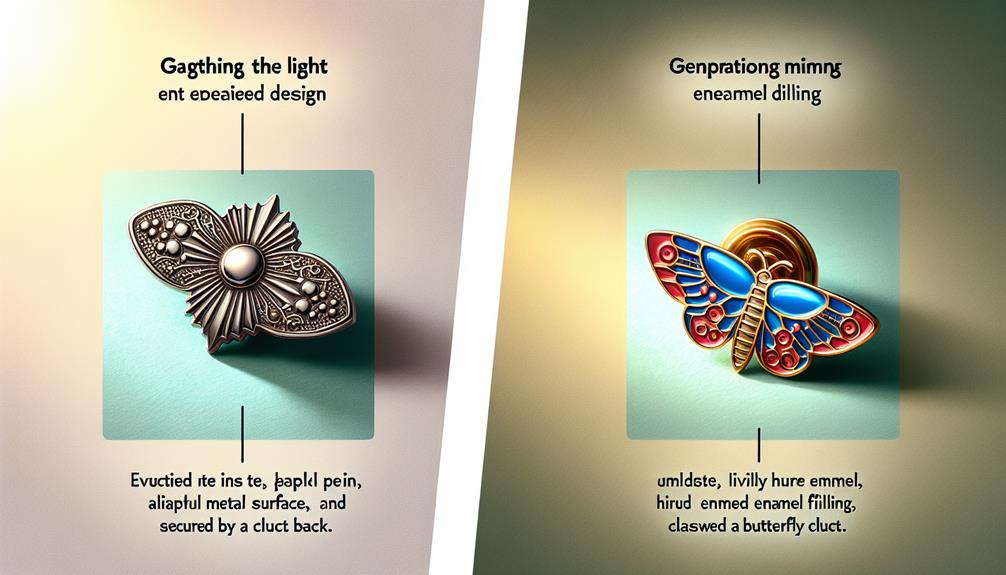Lapel pins and enamel pins are both popular accessories that have gained significant attention in recent years. While they may seem interchangeable at first glance, there are subtle yet significant differences between the two. Understanding these distinctions can help you make an informed choice when it comes to selecting the perfect pin for your needs.
From their purpose and design to the materials used in their construction, as well as their attachment and versatility, and even the range of customization options available, lapel pins and enamel pins each have their unique features that set them apart.
So, whether you're a collector, a fashion enthusiast, or simply curious about the world of pins, let's explore the intriguing dissimilarities between lapel pins and enamel pins.

The purpose and design of both lapel pins and enamel pins serve as distinct markers of affiliation, achievement, or support, with each possessing unique characteristics that distinguish them from one another.
Symbolism and meaning play a crucial role in defining the purpose of these pins. Lapel pins, often worn on the lapel of a suit jacket or blazer, are commonly used to represent membership in organizations, recognition of achievements, or support for a cause. They can feature logos, emblems, or other symbols that hold significance for the wearer or the organization they represent.
Enamel pins, on the other hand, are small, decorative pins made from enamel and metal. They have gained popularity in recent years for their collectibility and trading value. Enamel pins come in various designs, often showcasing unique artwork, pop culture references, or personal interests. Their purpose is to serve as a form of self-expression and to be collected and traded among enthusiasts.
The collectibility and trading aspect of enamel pins has given rise to a vibrant community of pin collectors who value the uniqueness and rarity of each design.

As we shift our focus to the subtopic of Materials and Construction, it is important to understand the key distinctions in the materials used and the construction methods employed for both lapel pins and enamel pins.
The manufacturing techniques used for lapel pins typically involve die-struck metal, where the design is stamped onto a base metal using a mold. On the other hand, enamel pins are crafted using a combination of metal and enamel fillings.
Here are four important points to consider regarding the materials and construction of lapel pins and enamel pins:
Understanding the manufacturing techniques, durability, and maintenance of lapel pins and enamel pins will help you make an informed decision when choosing between the two.

Attachment and versatility play crucial roles in determining the practicality and functionality of both lapel pins and enamel pins. When it comes to attachment, lapel pins typically feature a clutch or butterfly clutch back, which securely fastens the pin to clothing or accessories. On the other hand, enamel pins often have a rubber or metal clutch back, providing a reliable attachment method. This distinction in attachment mechanisms allows lapel pins to be easily removed and repositioned, while enamel pins offer a more permanent attachment.
In terms of versatility, lapel pins offer a wide range of styling options. They can be created in various shapes, sizes, and designs, allowing individuals to express their personal style or convey a specific message. Lapel pins also have the advantage of being able to incorporate different materials, such as metal, fabric, or even gemstones, further enhancing their aesthetic appeal.
Enamel pins, on the other hand, are known for their collectible value. They often feature intricate and detailed designs, making them highly sought after by collectors. Enamel pins can also be designed as limited editions or exclusive releases, increasing their collectible appeal and value.

What are the various ways in which lapel pins and enamel pins can be customized to meet individual preferences and branding needs?
Both lapel pins and enamel pins offer a range of customization options to ensure that they align with personal style and brand identity. Here are some popular customization options:
When comparing pricing, lapel pins and enamel pins generally have similar costs for customization options. However, the final price may vary depending on factors like pin material, size, quantity, and additional features. It is essential to consider these factors when deciding on customization options to ensure they align with the desired budget and requirements.

Lapel pins and enamel pins have gained significant popularity and are widely used in various industries and contexts. These pins have a long history of being used for different purposes, and their popularity has only grown over time. Lapel pins, also known as suit pins or badge pins, have a rich historical significance and are often used to signify membership, affiliation, or achievement. On the other hand, enamel pins have become increasingly popular in recent years due to their versatility and customizable designs.
Both lapel pins and enamel pins have cultural symbolism and can be used to represent a wide range of meanings. They can be used to showcase support for a cause, promote brand identity, commemorate special events, or simply add a touch of personal style to an outfit. The usage of these pins extends beyond fashion and can be seen in industries such as sports, politics, corporate branding, and even collectibles.
To better understand the popularity and usage of lapel pins and enamel pins, let's take a look at the following table:
| Lapel Pins | Enamel Pins |
|---|---|
| Historically significant | Modern and trendy |
| Often used for formal events | Suitable for various occasions |
| Symbol of affiliation or achievement | Customizable and versatile |
As you can see, lapel pins and enamel pins have their own unique characteristics and purposes, making them popular choices for individuals and organizations alike.
Lapel pins and enamel pins can be suitable for everyday wear, depending on the design and personal style. Everyday fashion allows for the incorporation of these pins as accessories to enhance one's outfit and make a statement.
Lapel pins and enamel pins can be highly effective promotional items, offering a unique and visually appealing way to communicate brand messages. However, their effectiveness depends on the target audience and the specific advantages and disadvantages of using them for branding purposes.
When wearing lapel pins or enamel pins, it is important to consider safety precautions to prevent any potential allergies or injuries. These precautions may include ensuring proper attachment, avoiding sharp edges, and considering potential allergic reactions to certain materials.
Lapel pins and enamel pins differ in terms of durability and longevity. Lapel pins, usually made of metal, tend to be more durable and long-lasting compared to enamel pins, which are made of enamel-coated materials.
Lapel pins and enamel pins can be considered collectible items due to current collecting trends. Their value estimation depends on factors such as rarity, design, and condition, making them sought-after by those who desire control over their collections.
In conclusion, while lapel pins and enamel pins share some similarities in purpose and design, they differ in materials and construction, attachment and versatility, as well as customization options.
Lapel pins are usually made of metal and have a more formal and traditional appearance, while enamel pins can be made of various materials and offer more creative and artistic designs.
Both types of pins have gained popularity and are widely used for self-expression, branding, and commemoration.
Elevate your brand or project with our specialized metal and non-metal nameplates. Gold Hot Industrial Co., Ltd. pioneers bespoke designs, catering to various industries. Whether for furniture labels, advertising, crafts, or more, our precision stamping and casting machines ensure top-quality products.
Contact us for a free quote for customizing your ideal lapel pins!

